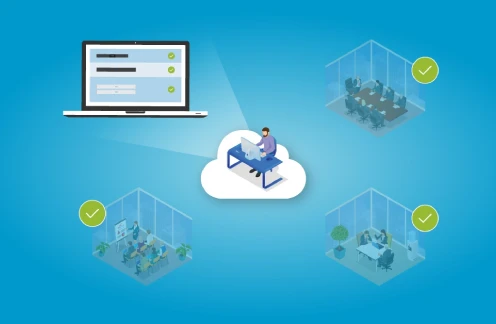What is RMM?
Remote Monitoring and Management (RMM) is a category of IT software that allows Managed Service Providers (MSPs) and internal IT teams to remotely observe, maintain, update, and troubleshoot endpoints and networks. It's the nerve center of any serious IT operation.
RMM software eliminates the need to physically touch a device to solve a problem. Instead, it gives you remote visibility and control over every asset in your IT environment—from servers and desktops to mobile devices and IoT hardware.
Think of it as your always-on, never-blinking IT watchdog—silently monitoring, automatically responding, and flagging issues before they become disasters.
Why RMM Matters More Than Ever
In a world where every device is a potential entry point and every update is a potential exploit, your ability to respond in real-time is non-negotiable. RMM isn't just helpful—it's mandatory.
Here’s why:
- Cyber threats don’t work 9 to 5. You need 24/7 monitoring, patching, and threat detection.
- Clients expect zero downtime. RMM tools allow you to fix problems before they’re noticed.
- Manual IT management is obsolete. Automation through RMM software slashes workloads and boosts accuracy.
- Hybrid and remote work are here to stay. Managing distributed endpoints is only feasible with robust RMM tools.
At ITarian, we believe RMM is the heartbeat of modern IT. And we’ve built a platform that’s not only fast and powerful—but also free for MSPs and businesses to start.
Key Features of ITarian’s RMM Software
Our RMM platform isn’t built for the past—it’s built for the chaotic future of IT. Here's what makes our RMM tools stand above the rest:
- 🔍Real-Time Monitoring
Continuously track device health, CPU usage, memory consumption, disk space, service statuses, and more across all endpoints—automatically. - 🛠️Remote Access & Troubleshooting
Access any system, resolve issues, push scripts, or chat with users—without disrupting their workflow or requiring on-site visits. - 🔄Automated Patch Management
Scan, schedule, and deploy patches across all Windows, Linux, and third-party software to close security holes and maintain compliance. - ⚙️IT Automation & Scripting
Create custom workflows and deploy scripts to handle repetitive tasks automatically—from restarting services to clearing cache to deploying updates. - 📊Custom Dashboards & Reporting
Get the data that matters. Create tailored dashboards and reports to track performance, uptime, compliance, and SLA adherence. - 🔐Built-In Security Integrations
Integrated with advanced antivirus, firewall, and EDR modules to ensure threats are monitored and neutralized directly from your RMM interface. - 📡Device & Network Discovery
Automatically detect and onboard new devices on the network. Ensure no endpoint goes unmonitored or unmanaged.
How RMM Tools Empower MSPs and IT Teams
Whether you're a Managed Service Provider serving hundreds of clients or an internal IT team overseeing a complex enterprise network, RMM tools unlock a new realm of control and agility.
Here’s how:
- Proactive IT Management
RMM alerts you to anomalies—disk nearing capacity, CPU overloads, failing services—before they impact operations. This shifts your team from reactive to predictive mode. - Scalable Operations
With RMM software, you can manage 10 endpoints or 10,000 with the same headcount. Scaling becomes a function of software, not staff. - Reduced Costs
Fewer truck rolls. Faster resolutions. Less downtime. All thanks to remote diagnostics, automation, and centralized control. - Improved Client Satisfaction
Clients love invisible IT. With RMM, you solve problems before they even know they exist, building trust and earning loyalty. - Data-Driven Decisions
The best IT leaders make decisions based on real data. RMM reporting gives you insight into system health, technician performance, and asset utilization.
ITarian’s Vision for RMM: Freedom, Function, and Future-Proofing
We believe every business deserves access to world-class IT tools—without breaking the bank. That’s why ITarian’s RMM is free to get started, packed with enterprise features, and built to scale as your needs grow.
But more than that, we’re reimagining RMM as the foundation of unified IT management. One console. One ecosystem. One mission: to help you deliver secure, resilient, and efficient IT.
Who Needs RMM Software?
If you’re asking “Do I need RMM?”—here’s the answer:
- ✔️MSPs managing multiple client networks
- ✔️IT departments with remote or hybrid workers
- ✔️SMBs looking to automate patching, monitoring, and reporting
- ✔️CISOs focused on endpoint compliance and threat prevention
- ✔️Helpdesk teams overloaded with manual tickets
RMM software is no longer a luxury. It's table stakes for surviving in the modern IT battlefield.
How to Choose the Right RMM Tools
With dozens of options out there, what should you look for in RMM software?
- ✅Comprehensive Monitoring– Not just alerts, but actionable data
- ✅Seamless Remote Access– Instant, secure access to any endpoint
- ✅Automation Engine– Script execution and workflow creation
- ✅Security Integration– Native threat visibility and control
- ✅Scalability– From startup to enterprise without re-platforming
- ✅Custom Reporting– Real-time and historical data visibility
- ✅Affordable Pricing– Or better yet, a free starting plan
ITarian delivers all of this—and more.
RMM + Security = Real Protection
At ITarian, we don't believe in monitoring without defense. That’s why our RMM isn’t just about dashboards and alerts. It’s tightly integrated with:
- 🔐 Antivirus and Antimalware
- 🧠 Endpoint Detection and Response (EDR)
- 🛡️ Firewall Configuration
- 📈 Compliance Reporting
This creates a closed-loop protection system where every alert can trigger an automated, intelligent, and effective response.

